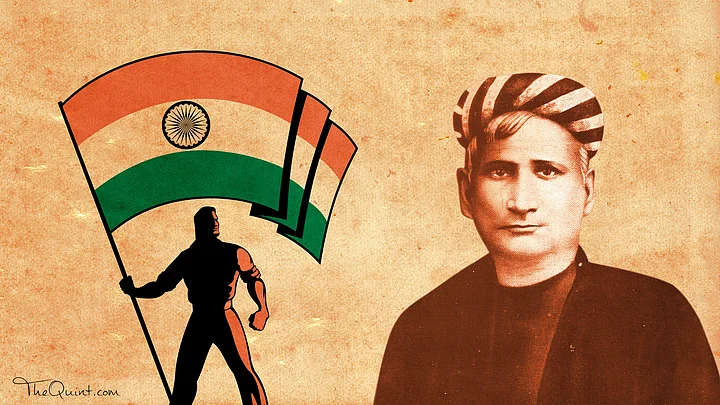(On the birth anniversary of Bankim Chandra Chatterjee’s, The Quint is reposting this article from its archives. It was originally published on 8 April 2017.)
When Bankim Chandra Chatterjee (1838-1894) composed Vande Mataram, he could not have anticipated the place it would acquire in the life of an entire culture. Originally written in the 1870s as a poem of devotion, an expanded version was later incorporated in the novel Anandamath in 1881. The musical score was composed by Rabindranath Tagore.
Chequered History
The iconic song had a chequered history. It was adopted as a slogan by the Swadeshi movement in Bengal from 1905, sung by Rabindranath Tagore as he led revolutionary marches and hailed by Aurobindo Ghose as the creation of a nationalist sage.
By the 1920s, it had been translated into diverse languages and attained recognition across the land.
From the 1930s, however, detractors, including MA Jinnah, began to question the idolatry they detected in the song. Through the 1930s and 1940s, the song remained controversial, raising Muslim ire and gaining the support of Hindu communalists.
In 1937, under Nehru’s leadership, a truncated version with the disputed lines removed was adopted by the Indian National Congress as our national song. This shorter version was designated the national song by the Constituent Assembly led by Rajendra Prasad in 1951, when Jana Gana Mana was declared the national anthem.
The Song that Captured the Imagination of the Nation
Ever since it came into the political domain, Vande Mataram has generated split responses, with some identifying it as an icon of Indian culture while others reject it as a communal instrument. At one time, the song was seen to express the collective aspirations of a people in search of nationhood.
For subsequent generations, it has come to occupy a place in the public imagination that has seen volatile shifts of allegiance according to changing contexts and different forms of ideological appropriation. Its popularity refuses to die down.
In 1997, AR Rahman set it to music in a way that tugged at millions of heartstrings. In 2002, a BBC poll showed it to be the second most popular song of all time. The song’s phenomenal public appeal demonstrates the power of words in the shaping of human societies.
The twelve-line original poem, probably written around 1875, conjures up a sublime vision of the motherland, captured in Aurobindo Ghose’s translation:
I bow to thee, Mother, …
Her nights rejoicing in the glory of the moonlight,
Her lands clothed beautifully with her trees in flowering bloom,
Sweet of laughter, sweet of speech,
The Mother, giver of boons, giver of bliss!
The lines that follow express the collective might of Indian resistance against British rule:
Terrible with the clamorous shout of seventy million throats,
And the sharpness of swords raised in twice seventy million hands,
Who sayeth to thee, Mother, that thou art weak?
Misuse as a Tool of Exclusionary Politics
It was in the lines later added to the song when Bankim wrote Anandamath (1881) that detractors found the signs of Hindu iconography that have caused controversy ever since.
Yet Bankim himself wrote in 1874, around the time when the poem was first composed:
Idolatry is anti-science. Wherever idolatry prevails, knowledge does not advance… It constrains man’s mind and diminishes his growth, improvement and development of human personality.
Despite Bankim’s declared stance, the extraordinary affective power of Vande Mataram has been repeatedly exploited at different historical moments, in support of exclusionary politics, sloganeering, communal vigilantism and partisan strong-arm tactics, in ways that subverted the author’s intent.
Also Read: Tharoor Hits Back: Muslims Have Right to Dissent on Loyalty Test
There Can’t be a Uniform Definition of Patriotism
Enforcing a single brand of nationalism as the only legitimate one goes against the very spirit of our culture, where ideas of nation and identity have always been diverse. Rabindranath Tagore, composer of the national anthems of two countries, strongly opposes monolithic definitions of nationhood and rejects Western models based on militarism and economic aggrandisement. For him, the “nation is a live entity, a psychological substance”.
In that subliminal element, the power to touch our great collective unconscious, lies in the magic of Bankim’s composition. Ironically, a song that has repeatedly demonstrated its power to draw the masses together has also become a dangerous instrument of divisive politics.
Also Read: Song of Synergy: An Anthem and a Vision
(Radha Chakravarty is writer, critic and translator. She teaches Comparative Literature and Translation Studies at Ambedkar University Delhi. This is an opinion piece and the views expressed above are the author’s own. The Quint neither endorses nor is responsible for the same.)
(This article was first published on 8 April 2017. It is being reposted to mark Bankim Chandra Chattopadhyay’s death anniversary.)
